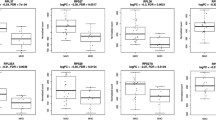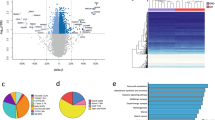Background
Few genes have been associated with the metabolic syndrome (MS), although its genetic component is well accepted. The aim of this study was to compare the adipose tissue gene expression profiles of obese men with and without the MS and to apply an integrative genomic approach to propose new candidate genes.
Methods
Affymetrix HG-U133 plus 2 arrays have been used for expression profiling of omental adipose tissue of non-diabetic obese men with (n=7) and without (n=7) the MS, as defined by the NCEP-ATPIII, that undergo a bariatric operation.
Results
Omentum expresses a total of 23 055 transcripts. Overall, 489 genes were differentially expressed between the two groups. A total of 80 differentially expressed genes were located within a previously identified region of linkage. In this subset of genes, zinc finger protein 36 (ZFP36) gene has been identified as the most promising genetic target for the MS-based mean fold expression differences and on biological plausibility. 2 out of 5 identified ZFP36 gene polymorphisms have been genotyped in a cohort of 698 obese subjects. The minor allele of these polymorphisms was associated with a lower body weight in women (rs251864; P≤0.01) and glucose level in men (c.1564_1565delTT; P<0.05). The haplogenotype was associated with plasma LDL-cholesterol levels in men and women (P≤0.02), and weight in women (P≤0.05). The haplogenotype was also associated with omental adipose tissue ZFP36 mRNA levels (n=83 women; P=0.02), and explained 10.1% of its variance.
Conclusion
These results suggest that converging genomics is helpful to prioritize MS-related candidate genes and that ZFP36 is a promising candidate gene for obesity-associated metabolic complications.
Similar content being viewed by others
Abbreviations
- MS:
-
metabolic syndrome
- CVD:
-
cardiovascular disease
- ZFP36:
-
zinc finger protein 36
- NCEP-ATPIII:
-
National Cholesterol Education Program -Adult Treatment Panel III
- QTLs:
-
quantitative trait loci
- AT:
-
adipose tissue
- mRNA:
-
messenger ribonucleic acid
- RT-PCR:
-
reverse transcriptase polymerase chain reaction
References
Després JP. Health consequences of visceral obesity. Ann Med 2001; 33: 534–41.
Iacobellis G, Ribaudo M, Zappaterreno A et al. Prevalence of uncomplicated obesity in an Italian obese population. Obes Res 2005; 13: 1116–22.
Bouchard C. Genetics and the metabolic syndrome. Int J Obes 1995; 19 (Suppl 1): S52–59.
Rice T, Nadeau A, Pérusse L et al. Familial correlations in the Quebec family study: cross-trait familial resemblance for body fat with plasma glucose and insulin. Diabetologia. 1996; 39: 1357–64.
Pérusse L, Rice T, Despres JP et al. Cross-trait familial resemblance for body fat and blood lipids: familial correlations in the Quebec Family Study. Arterioscler Thromb Vasc Biol 1997; 17: 3270–7.
McQueen MB, Bertram L, Rimm EB et al. A QTL genome scan of the metabolic syndrome and its component traits. BMC Genet 2003; 4 (Suppl 1): S96.
Stein CM, Song Y, Elston RC et al. Structural equation model-based genome scan for the metabolic syndrome. BMC Genet 2003; 4 (Suppl 1): S99.
Tang W, Miller MB, Rich SS et al. Linkage analysis of a composite factor for the multiple metabolic syndrome: the National Heart, Lung, and Blood Institute Family Heart Study. Diabetes 2003; 52: 2840–7.
Loos RJ, Katzmarzyk PT, Rao DC et al. Genome-ZP36 and the Metabolic Syndrome wide linkage scan for the metabolic syndrome in the HERITAGE Family Study. J Clin Endocrinol Metab 2003; 88: 5935–43.
Ng MC, So WY, Lam VK et al. Genome-wide scan for metabolic syndrome and related quantitative traits in Hong Kong Chinese and confirmation of a susceptibility locus on chromosome 1q21–q25. Diabetes 2004; 53: 2676–83.
Bossé Y, Després JP, Chagnon YC et al. A quantitative trait locus on 15q for a composite metabolic syndrome variable derived from factor analysis in the Quebec Family Study. Obesity (in press).
Wajchenberg BL. Subcutaneous and visceral adipose tissue: their relation to the metabolic syndrome. Endocr Rev 2000; 21: 697–738.
Schadt EE, Lamb J, Yang X et al. An integrative genomics approach to infer causal associations between gene expression and disease. Nat Genet 2005; 37: 710–7.
Yagil C, Hubner N, Monti J et al. Identification of hypertension-related genes through an integrated genomic-transcriptomic approach. Circ Res 2005; 96: 617–25.
Vohl M, Sladek R, Robitaille J et al. A survey of genes differentially expressed in subcutaneous and visceral adipose tissue in men. Obes Res 2004; 12: 1217–22.
Robitaille J, Despres JP, Perusse L et al. The PPARgamma P12A polymorphism modulates the relationship between dietary fat intake and components of the metabolic syndrome: results from the Quebec Family Study. Clin Genet 2003; 63: 109–16.
Executive Summary of The Third Report of The National Cholesterol Education Program (NCEP) Expert Panel on Detection, Evaluation, and Treatment of High Blood Cholesterol In Adults (Adult Treatment Panel III). JAMA 2001; 285: 2486–97.
Affymetrix I. GeneChip Analysis Technical Manual, Rev. 5. 2004.
Livak KJ, Schmittgen TD. Analysis of relative gene expression data using real-time quantitative PCR and the 2(-Delta Delta C(T)) Method. Methods 2001; 25: 402–8.
Stephens M, Smith NJ, Donnelly P. A new statistical method for haplotype reconstruction from population data. Am J Hum Genet 2001; 68: 978–89.
Stephens M, Donnelly P. A comparison of bayesian methods for haplotype reconstruction from population genotype data. Am J Hum Genet 2003; 73: 1162–9.
Bolduc C, Larose M, Lafond N et al. Adipose tissue transcriptome by serial analysis of gene expression. Obes Res 2004; 12: 750–7.
Donninger H, Bonome T, Radonovich M et al. Whole genome expression profiling of advance stage papillary serous ovarian cancer reveals activated pathways. Oncogene 2004; 23: 8065–77.
Lai WS, Stumpo DJ, Blackshear PJ. Rapid insulinstimulated accumulation of an mRNA encoding a proline-rich protein. J Biol Chem 1990; 265: 16556–63.
Carballo E, Lai WS, Blackshear PJ. Feedback inhibition of macrophage tumor necrosis factor-alpha production by tristetraprolin. Science 1998; 281: 1001–5.
Lee YH, Pratley RE. The evolving role of inflammation in obesity and the metabolic syndrome. Curr Diab Rep 2005; 5: 70–5.
Carrick DM, Lai WS, Blackshear PJ. The tandem CCCH zinc finger protein tristetraprolin and its relevance to cytokine mRNA turnover and arthritis. Arthritis Res Ther 2004; 6: 248–64.
Ford ES, Giles WH, Dietz WH. Prevalence of the metabolic syndrome among US adults: findings from the third National Health and Nutrition Examination Survey. JAMA 2002; 287: 356–9.
Author information
Authors and Affiliations
Corresponding author
Rights and permissions
About this article
Cite this article
Bouchard, L., Tchernof, A., Deshaies, Y. et al. ZFP36: a Promising Candidate Gene for Obesity-Related Metabolic Complications Identified by Converging Genomics. OBES SURG 17, 372–382 (2007). https://doi.org/10.1007/s11695-007-9067-5
Received:
Accepted:
Published:
Issue Date:
DOI: https://doi.org/10.1007/s11695-007-9067-5




